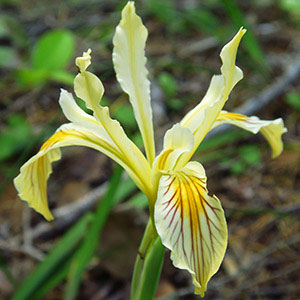Iris hartwegii
Iris bracteata
Hartweg's iris, rainbow iris, Sierra iris
Siskiyou iris
creeping, not producing dense clumps, covered with remains of old leaves, slender to moderately thick, 0.5–0.9 cm diam.;
roots fibrous.
sheathed with old leaf bases, slender, 0.6–0.9 cm diam.;
roots few, fibrous.
simple, solid, 0.5–3 dm.
simple, solid, 1.5–3 dm.
basal deciduous, blade pale green, not pink basally, 2–4.5 dm × 0.2–0.6(–1) cm, sometimes glaucous, margins not thickened;
cauline usually 1–several, spreading, sheathing for about 1/2 length, foliaceous, blade not inflated.
basal with abaxial surface of blades deep glossy green on one side of fan, light yellow-green on other side, pink or red-tinged basally, strongly ribbed, 4–6 dm × 0.8–1 cm, rigid, margins not thickened;
cauline 3–6, imbricated, closely sheathing stem ca. 2/3 length, spreading distally, bractlike, blade inflated, often shorter than basal leaves.
1–2(–3)-flowered;
spathes divergent, separated by 1.5–4 cm, linear to linear-lanceolate, unequal, outer 5–11 cm × 4–7 mm, inner 5–6 cm × 2–3 mm, herbaceous, apex acute.
simple, units 1–2-flowered;
spathes closed tightly around pedicel and ovary, lanceolate, 5.2–9 cm × 6–8 mm, subequal, herbaceous, margins scarious, apex acuminate.
perianth lavender, cream, or pale to deep yellow;
floral tube funnelform, 0.5–1(–1.5) cm;
sepals oblanceolate, 4–7 × 1.4–2 cm, base gradually attenuate;
petals narrowly oblanceolate, 3.5–6 × 0.5–1.1 cm, widest at about 1/2 their length, base abruptly attenuate, claw 1–2 mm wide;
ovary nearly cylindrical, 1–2 cm;
style 1.6–3 cm, crests overlapping, obtusely angled, 0.5–1.1 cm;
stigmas acutely triangular, margins entire;
pedicel 0.5–2.5 cm at anthesis, lengthening to 3.5–7.5 cm at maturity.
perianth cream to buff-yellow;
floral tube 0.8–0.9 cm;
sepals with deeper yellow signal, veined with purple or brown, obovate-lanceolate, 6.5 × 2.5 cm, base gradually attenuate into wide claw;
petals narrowly oblanceolate, 7–9 × 0.8–2 cm, base gradually attenuate;
ovary nearly circular in cross section, 1.5–2.5 cm, base gradually attenuate into pedicel, apex abruptly acuminate into floral tube;
style 2.2–3 cm, crests spreading, yellow, not veined, 1.2 × 0.9–1.7 cm, margins toothed;
stigmas triangular or tongue-shaped, margins entire;
pedicel 3–6.2 cm.
oblong-oval, 3-angled, tapering abruptly at either end, 2–3 cm.
nearly circular in cross section, tapering abruptly at each end, 2–2.5 × 1–1.5 cm.
brown, irregularly D-shaped, wrinkled.
dark brown, irregular in shape, wrinkled.
= 40.
= 40.
Iris hartwegii
Iris bracteata
Plants with pedicels 2.8–4.7 cm, and flowers light purple or bluish violet have been recognized as subsp. australis. Plants having a 3-flowered inflorescence unit, leaves about 1 cm wide, and pale yellow flowers with golden yellow veining have been called subsp. columbiana. Plants having both flowers open at the same time rather than consecutively, pedicels averaging only 1 cm, long narrow style arms and crests, and floral tubes 1.2–1.5 cm have been named subsp. pinetorum.
Iris hartwegii hybridizes with I. douglasiana, I. innominata, I. macrosiphon, I. munzii, I. tenax, and I. tenuissima. It is known from Butte County to Kern County.
(Discussion copyrighted by Flora of North America; reprinted with permission.)
Iris bracteata is limited to one county each in northern California and southern Oregon. It hybridizes with I. chrysophylla, I. douglasiana, I. innominata, I. munzii, I. purdyi, and I. tenax.
(Discussion copyrighted by Flora of North America; reprinted with permission.)


